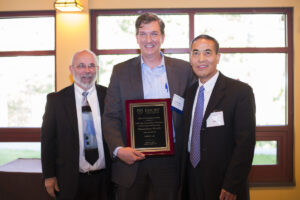Each Spring, Emory’s Office of Technology Transfer hosts an Annual Celebration of Technology and Innovation. In preparation of announcing the 2021 awardees, we spoke with several award recipients from previous years about their experience with OTT’s Annual Celebration.
2009 Innovation of the Year – Novel PET Imaging Agents; Mark Goodman, Ph.D.
Can you introduce yourself?
“I am Mark Goodman; I am a professor of Radiology and Imaging Sciences. I have secondary appointments in the Department of Psychiatry and Behavioral Sciences and the Department of Hematology and Medical Oncology. I am the Emory Endowed Chair in Imaging Science.”
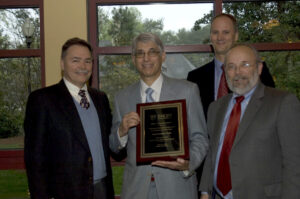
Fred Sanfalippo, Exec. VP Health Affairs; Mark Goodman, inventor; Cale Lennon, case manager; David Wynes, VP Research Admin.
What did you enjoy about winning an award/attending the reception?
“It was most gratifying to be recognized for developing translatable technologies that can help manage diseases. Also to recognize my colleagues who participated and helped bring the technology to the point where OTT recognized it as something that was important and deserved an award. And of course, I enjoyed having my family there as well. I have been married for 42 years and when you embark on an academic career you have to have the support to be able to put in the time and the effort to accomplish something.”
Can you tell us about the award you received and how you felt when you learned you were receiving an award?
“The first one I received was in 2009. It was an award that recognized a new technology. It was an imaging agent for cancer that would use nuclear medicine imaging. It felt quite wonderful to have the University and OTT pick that achievement as something they wanted to recognize.”
Did the award have any impact on your lab or family?
“It impacted my lab because it gave us more notoriety amongst our peers. That work enabled us to secure NIH funding in that area, several grants. That helped fund scientists and staff in the laboratory. It helped maintain the lab and secure people’s futures. I have had funding every year for 27 years, so I am quite fortunate in that regard. The award helped me further build my program.”
Is there anything else you would like to share about the experience?
“The celebration was very nice, you got to see colleagues who also received awards. Their labs and families attended. You get to talk and mingle, and sometimes you end up meeting future colleagues in the event. It’s also nice to have your family there to celebrate and share the honor with you. It is a certainly a very lovely celebration.”
Can you use one word to describe the event?
“The words I choose are ‘gratification’ and ‘appreciation’. Gratification for receiving the award and then appreciation for Emory and OTT to actually recognize faculty.”
2017 Innovation of the Year – Frog Skin Peptides as Inhibitors Of Influenza & Zika Virus; Joshy Jacob, Ph.D.
Can you tell us about the award you received and the innovation it was for?
“We looked at peptides from the skin of frogs to see if any of those peptides can inhibit viruses that infect humans. There are small peptides called antimicrobial peptides that are found in all lifeforms, and they have very broad reactivity. We just wanted to know, if any of these peptides that the frog makes in its skin be cross utilized to human viruses. Using this method, we have found peptides that can kill not just influenza, but Zika and Dengue viruses as well. A peptide is a small run of amino acids. If you took individual amino acids put them like beads on a string, and you have a short piece of them, it would be a peptide. The full string would be a protein.”
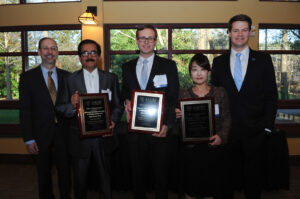
Jonathan Lewin, Executive VP Health Affairs; Joshy Jacob, David Holthausen, Song Hee Lee, inventors; Justin Burns, case manager
What did you enjoy about winning an award/attending the reception?
“Winning the award came as a surprise. I was actually very excited about it because it gave us the acceptance that people think that this is important work. Attending the celebration was actually a lot of fun because I got to meet a lot of fellow innovators at Emory University. Also, there were a lot of people there that were like venture capitalists. It’s always good to see any of the people from Emory University that I have worked with closely.”
Did the award have any impact on your lab or family?
“The impact was that it was given to me, my Ph.D. student, and my post-doc. All of us got to go up there and stand on the stage and receive it which was very joyful. And my student was overjoyed and so was my post-doc, so that made me happy.”
What has happened since the award?
“We have extended those studies with peptides. Then COVID-19 came about and then we stopped all that and moved into COVID work. When it calms down, we are going to go back again to the frog peptide story.”
Can you tell us a little about the COVID work that you are doing right now?
“We have tried to find a peptide that can actually inhibit the SARS coronavirus. We looked across animals that have coronavirus in them naturally, or those that cannot be infected by the SARS coronavirus. We picked one family of peptides so that we could cover a whole lot more animals. We looked at 40 different animals and we screened 300 different peptides. We have two that actually inhibit coronavirus, and I have filed an invention disclosure with OTT.”
Can you use one word to describe the event?
“Joyful.”
2018 Start-Up of the Year – EMRGE, LLC; Monte Eaves, MD
Can you introduce yourself?
“I am Monte Eaves; I am a plastic surgeon. I used to be a professor at Emory in the division of Plastic Surgery in the Department of Surgery. As of September 1, with some changes associated with COVID and with our company becoming commercially active, I left Emory and now I practice part-time with my wife in a practice called ME Plastic Surgery in Atlanta.”
What did you enjoy about winning an award/attending the reception?
“I think for me, the thing that struck me was the sense of community that came out of the reception. At Emory, we get a lot of support from Tech Transfer for multiple projects. It’s also wonderful when you can get all of these different groups together because you can see that even though we are all spread out, it is indeed a community. The other thing that was so exciting was that many people on my team were able to come for the ceremony. For them to see what we are doing through the eyes of Emory, Tech Transfer, and others in the Atlanta entrepreneurial community was very reassuring for them and showed them that we were on a good path and going in the right direction.”
Can you tell us a little about the invention that you received the award for?
“The technology we developed is called a force modulating tissue bridge. The device is intended for non-invasive wound closure, but at the same time, it takes all of the tension off of the skin, so it is also designed to improve scar outcomes, as we know that the primary driver of poor scarring is tension. It can be reapplied in the healing period. It’s a very simple concept, but what is exciting is that there was a lot of engineering underneath it to get the different components to move and rotate right, and to figure out all of the manufacturing.”
Did the award have any impact on your lab or family?
“It was exciting. For my wife and kids, it was important that they see that what I was spending all my nights doing was moving somewhere; It’s not just a theory, it’s not a ‘maybe’ and it’s not just a pipedream. It was something that could come together and be a product, be a company, and make an impact for patients. It was reassuring for them in that way. I think it’s also helpful later when fundraising, to show that you have been recognized as a company and as a startup. That gives potential investors some reassurance, it’s one of the many pieces of the puzzle.”
What has happened since the award?
“When we got the award, we had prototypes and we knew what we wanted to build but we had none of the manufacturing figured out. We spent a few years to get that developed because we had to design and validate our own custom manufacturing machinery. We had a product release in September of 2020, and it is now being used clinically. We had our first sale in January 2021. We are in the process of preparing for a full commercial launch and building up our inventory.”
Is there anything else you would like to share about the experience?
“The one thing I would share, especially for people interested in developing a product, is that Tech Transfer can be a tremendous resource, especially the way that Tech Transfer can make connections. For me, a critical connection originating from Tech Transfer was with GRA (Georgia Research Alliance) which has been a great supporter and has provided me with key mentorship. Tech Transfer can get people started and is really helpful.”
Can you use one word to describe the event?
“Affirmative. It provides you that sense of clarity and security that you are going down the right path. It really affirms what you are doing.”
2018 Innovation of the Year – Messenger RNA-Based Biopacemaker; Hee Cheol Cho, Ph.D.
Can you introduce yourself?
“My name is Hee Cheol Cho, I am an associate professor in the Department of Pediatrics. I hold the title of Urowsky-Sahr Scholar in Pediatric Bioengineering and I am also the director of the Heart Regeneration Program at the Children’s Heart Center of Children’s Healthcare of Atlanta.”
What did you enjoy about winning an award/attending the reception?
“I was beyond excited to win the award of “2018 Innovation of The Year”. It was a huge honor to say the least, that our technology was picked as the best one. The award reception was one that I had never attended in that style. They gather all the up-and-coming technologies that are licensed from Emory University. I got to meet a lot of entrepreneurs at the reception. Not only the people being awarded, but also awardees from previous years. Getting in that mix was a lot of fun and very insightful for me as our inventions are just getting into technology transfer and development.”
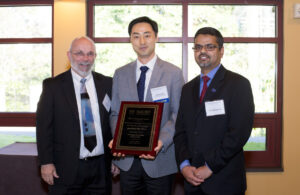
David Wynes, VP of Research Administration; Hee Cheol Cho, inventor; Raj Guddneppanavar, case manager
Can you tell us a little bit more about the technology that you received the award for?
“The title of the technology was “Messenger RNA-Based BioPacemaker.” The idea is to create a pacemaker using cells or genes. A few years ago, we found a way to pace the heart by injecting a natural human gene. Our gene technology was able to convert ordinary heart muscle into new cardiac pacemaker cells. These new biological pacemaker looked and functioned like the natural pacemaker that we are born with. To advance this technology into a therapy, we succeeded in developing messenger RNA-based gene therapy. mRNA is a perfect gene delivery platform for our biological pacemakers. We took advantage of the brief life time of mRNA, and demonstrated that the gene is no longer needed once the biological pacemakers are created. It is serendipitous that the safety of mRNA-based gene delivery is now confirmed with the Covid-19 vaccines. Our gene therapy invention delivers the pacemaker gene into the patients in the safest way possible. In the next 5-10 years, we are hopeful that we will provide alternative, device-free cardiac pacing therapy for patients who are dependent on pacemakers. We are particularly excited with the potential improvements in clinical care and outcomes with pediatric patients. Current pacemakers are far from ideal and at times inadequate for the newborns and infants who require a pacemaker.”
Did the award have any impact on your lab or family?
“Absolutely. For our lab, the award itself was the beginning of other opportunities that were presented to us. We have been able to secure three major NIH funding as well as a preclinical technology development award from the U.S. Department of Defense. The award has also attracted interests to eventually develop the technology into commercial products.”
What has happened since the award?
“The award also opened the door for more collaboration. Since we received the award, our collaborations have expanded beyond the labs at Emory and Georgia Tech. We have also started conversations with potential industry partners to plan for the road ahead in terms of the data needed for the first human trial. It is not an understatement to say that the award has been a huge windfall for advancing the technology to a clinical reality.”
Is there anything else you would like to share about the experience?
“The award was important because with that I was able to form a stronger bond with the OTT office. There had been a lot of interest from venture capitalists as well as other investors who are interested in taking our technology into the commercial product development pipeline. We are looking into that aspect as well. From technology development to ultimate translation into therapy, the award has been a key that connected those efforts.”
Can you use one word to describe the event?
“I can summarize my experience with the award as ‘catalyst’. We have worked hard to get to the point to win the award, and after the award a lot of opportunities were presented to us. We took advantage of those opportunities and built our research portfolios even more. I think that the award and event was a definitive catalyst for our research.”
2019 Innovation of the Year – Alexidine and Analogs to Treat Lung Cancer; Adam Marcus, Ph.D.
Can You Introduce yourself?
“I am a professor in the Department of Hematology and Medical Oncology. I am also the associate director for basic research and shared resources at Winship, and currently serve as the interim executive director of Winship. On the lab side, my work is mainly as a cancer cell biologist where we look at how cancer cells metastasize and then determine how best to stop that metastasis using small molecule inhibitor strategies.”
Can you tell us a little about the award that you received and the technology that it was for?
“A couple of years back, we were awarded the Innovation of the Year Award from OTT for the discovery of analogs of Alexidine. These alexidine analogs are modifications to the chemical structure of Alexidine to make it more potent by targeting the highly invasive cancer cells that spread. The analogs do this by changing the way that these cells process energy, to reduce their ability to metastasize and spread, as well as their ability to grow. The Innovation of the Year award was for the discovery and studies that test the efficacy of alexidine analogs in lung cancer, and especially lung cancer metastasis, which is the primary reason for patient mortality.”
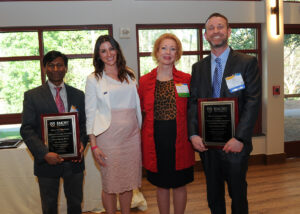
Thota Ganesh, inventor; Sarah Wilkening, case manager; Deborah Bruner, SVP for Research; Adam Marcus, inventor
What did you enjoy about winning an award/attending the reception?
“It is exciting to get recognition for the work your team has done, being a part of the OTT process and getting to know everyone. The award gave us the opportunity to talk about our research in a large venue to people that have a variety of careers at Emory.”
How did you feel when you learned you were receiving an award?
“The award itself is recognition for the accomplishments and the amount of work that goes into this research from several different people. The work was conducted by a former graduate student, a chemist, and several other researchers in the lab. Receiving this award generates more momentum and excitement for this project.”
Did the award have any impact on your lab or family? What has happened since the award?
“Since receiving the award, our team obtained funding from Biolocity, which provides funds to Emory and Georgia Tech investigators. It has enabled us to test our compound in more clinically relevant scenarios, where we perform pre-clinical trials in mice and tested the compound to see if it works on lung cancer in a mouse. Those results have been very promising. On top of that, we recently found out that we received the Phase 1b award from the Georgia Research Alliance. We have been able to expand and further develop the compound, and we are excited for the future to see where we can take this. Ideally, in the future, we will have a Phase 1 trial in human patients.”
Is there anything else you would like to share about the experience?
“It’s always fantastic to get support from the university, and this research has had the university’s support from the start. Receiving the initial pilot awards has helped us become competitive for external funding. In fact, we have pending funding made possible by the team’s progress and recognition to date from the National Cancer Institute. It has been fantastic to receive the initial support, and to be recognized by the Office of Technology Transfer. It’s an exciting time for the lab and we are excited to push this forward.”
Can you use one word to describe the event?
“Energy. The room was filled with excitement and enthusiasm for science all across Emory.”
